

In this article, you will learn how to detect fake products created with the help of artificial intelligence on marketplaces and online stores. The authors explain how to recognize fakes by visual signs, avoid online fraud, and check the authenticity of products before purchasing. This is a practical guide that will help you protect yourself from AI-generated products and make online purchases safely.
Drinking coffee from a cup carved from minerals and adorned with amethysts, rose quartz, and other crystals sounds like a scene from a fairy tale.
But, as it turned out for many customers, it was just an illusion.
Advertisements like the one on Facebook below began to appear online: they offered “artisanal” mugs with crystals in various shades – pink, blue, green. Such cups were sold both through small social media pages and on large platforms, including Amazon. However, when the order was delivered, customers were surprised – and not in a good way.
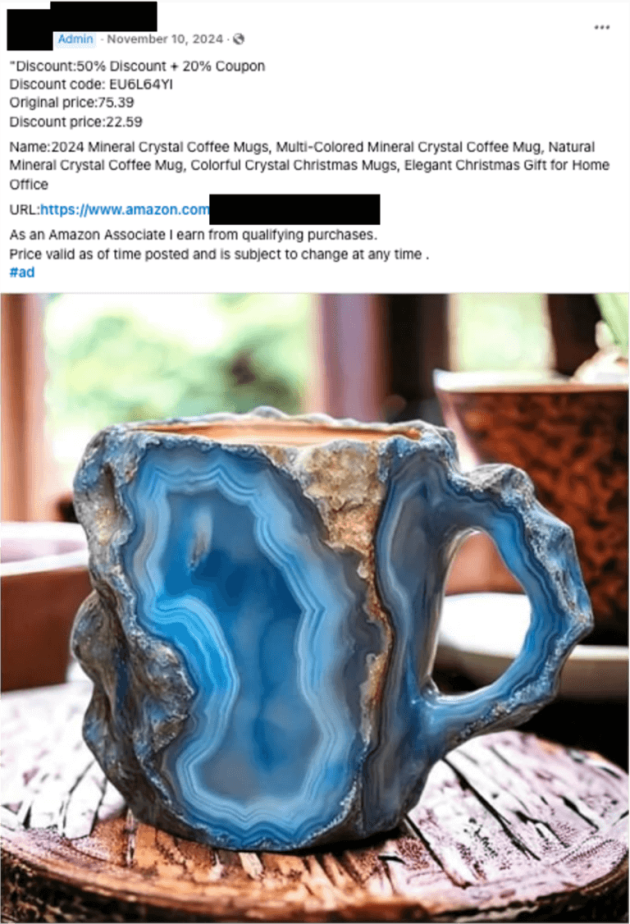
In the comments section of this Facebook post, users shared images of the mugs they had purchased that bore little resemblance to the fancy images on the listing.
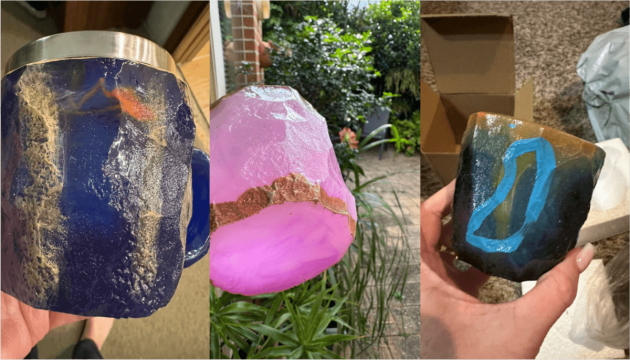
Significant advances in artificial intelligence in recent years have made it more difficult to distinguish between the real and the fake, not only when it comes to photos and videos of people, but also in product listings.
There has also been an increase in the number of books created by artificial intelligence being sold on platforms, including Amazon, with some even appearing in libraries without any notice that they were created by artificial intelligence.
But AI isn’t perfect, and if you look closely, you can often spot a few telltale signs of a fake. In this guide, we’ll walk you through some questions savvy shoppers can ask to identify red flags using just critical thinking and basic research tools.
Many images created by artificial intelligence have a certain “gloss” or appearance that can be disconcerting.
Take this image of one of the “crystal coffee mugs.” At first glance, it looks like a beautiful mug. But if you look closely, you can see flaws in the image.
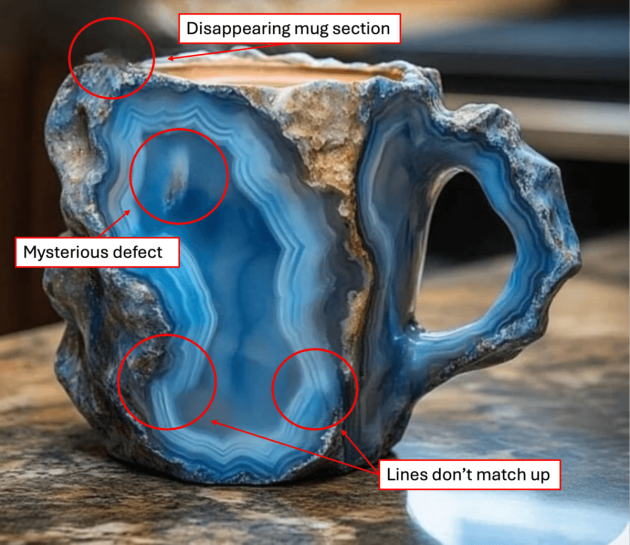
In the photo of the mug, you can see a few areas where the “crystal” patterns don’t connect properly. Such broken or chaotic lines are a red flag. In the center of the cup, there is a strange spot that looks more like an artificial mark from a digital brush than a natural chip or inclusion in the stone. Its blurring is a typical artifact of images generated by artificial intelligence. And at the top of the mug, part of the shape gradually dissolves into the background — another sign of digital editing or generation.
In addition to visual clues, it’s worth considering how realistic the idea of such a product is. For example, the mug in another image looks like it was carved from volcanic rock, with cracks that glow red. The light inside looks unnatural, like in a scene from a video game, and there are no wires or descriptions of a power source. This is also suspicious – a real product with such properties should require a battery, or at least a mention of one. All these details hint at one thing: you are not looking at a photo of a real object, but a work of AI fantasy.
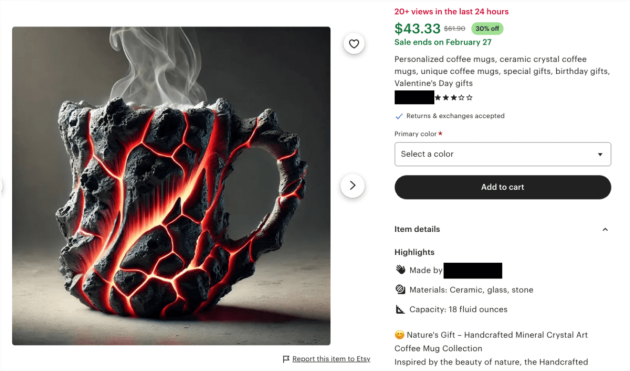
AI image generators can create compelling images, but they’re not good at creating identical images. Authentic listings often show the same item from multiple angles so that customers can see what the item looks like before they buy. If you only see one photo of the item, that’s a sign that the listing may be using an AI-generated image. Sellers often take one amazing photo and post the item in multiple “scenes,” but you may notice that they don’t show a different angle of the item.
If there are multiple photos of a product, it’s also worth considering whether it looks like the same product in all the images. The Etsy listing below for crocheted Highland cows, for example, has multiple photos of crocheted Highland cows, but they don’t always have the same pattern or design.
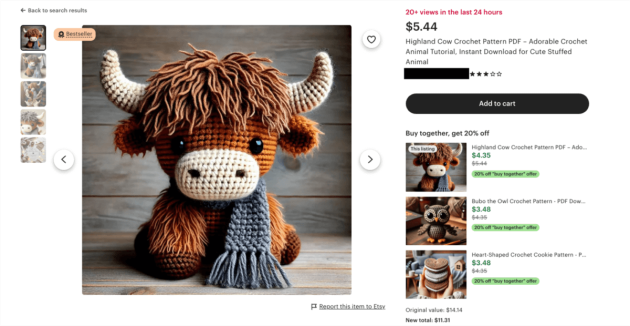

If this list is positioned as a pattern — that is, a ready-made instruction, according to which needlewomen can create the same toy — then the fact that the images show cows with different shapes, colors and materials raises serious suspicions. It looks as if the pictures were generated using AI, which could not create the same product twice.
Look closely — it is in them that the truth is often hidden. For example, in the first photo you can see that the cow’s nostrils have a different shape. In other photos, the shape of these same nostrils changes again. The same applies to the horns, body, hooves, even the scarf — in each photo they are slightly different, which excludes the real physical existence of the same product.
Another obvious sign of a fake is the texture. Those familiar with crochet will immediately notice: the “hair” on the head, legs, and torso doesn’t look like regular yarn, but rather like something graphic, unrealistic. In one of the comments to a buyer’s complaint, the seller even admitted that all of these images were generated by artificial intelligence.

Here’s a deeply reworked and natural version of this snippet:
To avoid being blocked or accused of fraud, some sellers intentionally hide important information in small text or word it vaguely, hoping that most buyers won’t read the details. And if caught, they’ll simply say that the image is just an illustration and don’t promise full compliance.
To avoid falling into this trap, it’s important to carefully check the product description: what exactly the product is made of, what its dimensions are, and whether it says anywhere that the photo is the result of artificial intelligence. Sometimes sellers subtly hint that the actual product may differ — for example, by indicating that the design has a “mineral” style, rather than being truly carved from stone.
In the case of cups, some descriptions honestly hint that they’re not talking about natural crystals, but only about the appearance. Another example is the animalistic jewelry on eBay that looks three-dimensional and photorealistic. But if you read the title carefully, you can find a clarification: it is actually a flat two-dimensional product.

In one Reddit post, a user said they purchased pet ornaments similar to the ones on this list. According to their report, the ornaments they received were flat acrylic discs with images printed on them. If — as in the listing we saw — the seller has made this clear in some way in the title or description, it may be harder for buyers who purchased ornaments based solely on AI-generated images to seek a refund.
Scammers rely on people making impulse purchases. Being consistent in reading the details can protect you from these surprises.

Fake reviews can appear on almost any platform, not just retail websites. There are entire networks dedicated to creating fake reviews, so we can’t just rely on positive customer reviews to determine whether a product is trustworthy to buy.
It’s much harder to fake a review with real photos of the product than just writing text, so the images can often provide the most important information.
In addition to reading reviews, pay attention: Has anyone posted a photo of the product taken at home? Does the image look lively, with a natural background — a room, a table, a human hand? Or is it just a copy from the seller’s main ad? It’s also important to compare: does the item in the photo actually look the same as the listing, or are there any discrepancies?
If you come across a product with no reviews or see that the page has recently appeared, it’s worth doing a reverse image search. This allows you to find older versions of the listing or even other stores where the same item was previously sold — perhaps with negative reviews. Often, unscrupulous sellers simply delete the previous listing after a wave of complaints and launch a new one with the same image.
It’s also a good idea to check if the product is being sold elsewhere. If you see the same images on all platforms without any actual photos from buyers, it’s a good idea to take a moment to check. In such cases, it’s better to spend a little time checking than to regret your purchase later.
Many of us, when buying online, strive to find the most advantageous offer – after all, it is nice to get the most for our money. But it is worth remembering: sometimes an overly attractive price is not a bargain, but a signal of possible fraud.
Compare prices carefully. If the difference between similar products is not a couple of hryvnias, but tens or even hundreds, it is worth thinking about it. A truly high-quality and complex product can hardly cost a penny. For example, if you see a voluminous handmade sweater for a pittance, this is already a reason to be wary.
In such situations, reverse image search is very helpful. If the same product with the same photo is sold on different platforms at radically different prices, this is another alarm signal. Yes, sometimes the reason can be completely legal – the country of the seller, bulk purchase or sale. But very often it is just a tool of scammers who lure with a low price and do not deliver anything or send the wrong thing at all.
A prime example is a stained glass cat lamp that sells for less than $23 on Walmart, Amazon, and eBay. That seems suspiciously cheap for such a complex product—so it’s always a good idea to check the product’s provenance, reviews, and images.

A search for similar stained glass lamps online reveals a very different picture: most of them have a simple dome shape and cost at least $100. And given that the cat lamp has an intricate design and detailed shape, it should logically be even more expensive to manufacture — but it sells for less than $25.
Another caveat — a Google image search for keywords like “stained glass lamp cat” mainly returns photos of square, simplified versions. All other models, except for the same “popular” cat lamp, cost significantly more. This suggests not only that such a price is abnormally low, but also that the design itself is not typical of genuine products of this type.
Yes, the difference in price can sometimes be explained by the brand or country of manufacture. But in this case, such a large discrepancy is a red flag that should not be ignored. It is a reason to check the seller, the origin of the product, and the reality of the offer so as not to fall into the trap of scammers.

In this case, a reverse image search for this lamp revealed that some customers who ordered it received a cheap plastic item with airbrushed paint rather than stained glass, and nothing close to the item listed.

Finally, it’s always a good idea to look beyond the list and consider who is making a profit from the purchase.
Is this a branded item or does it seem like some mysterious seller who appeared overnight? Does this seller have a website or is it only on Facebook or Amazon? Is the seller’s account new? If they sell other items, what do the customer reviews say? Does the seller use an AI-generated image as their profile picture?
If you’re buying a book, look into who the author is. Does this person exist? Is the book a legitimate publisher, or is it just through Amazon’s self-publishing? While self-publishing doesn’t automatically mean the book is untrustworthy, the process has fewer checks and balances than books from publishers, who typically go through a pre-release review process.
Searching for the author online should reveal other information about them. If they are real, does it seem like they wrote the book? Are they promoting it on other platforms? Could someone have used their name without permission?
For example, the cookbook below lists the author as “Ethan Nelife.” Their Amazon bio describes them as “an accomplished author,” but a search for their name turned up nothing but cached listings of the book on various Amazon online marketplaces that are no longer available. There were no social media profiles or personal websites under that name, no articles about their books, or any contact information available online.

A reverse search of the profile image across several search engines failed to find any exact matches, except for Amazon pages. However, the results did show stock images labeled as AI-generated.
One such example is an image from the site FreePik, which specializes in AI-generated stock graphics. There was a photo called “Portrait of a Businessman on a White Background,” created with Midjourney 6, that looked almost identical to the profile avatar named “Ethan Nelife.”
If, during a reverse search of a profile, the system suggests images from sites that publish AI-generated faces, this may indicate that the avatar itself you are checking is also the result of the work of a neural network. Such a finding is another red flag that you are facing a fictional persona created to cover up a fake account or a dubious business.

These simple checks should be done before you buy — they will help you make sure that the book or product is really being sold by a legitimate company or real person. Of course, there are small businesses or private craftsmen who, for privacy reasons, leave a minimum of information about themselves online. But if you have doubts, it is better not to ignore them, but to spend a few minutes on basic online research. This will help you understand whether you are dealing with a reliable seller — or someone who is simply masquerading as one.
The world of online shopping is changing rapidly—and getting more complicated. With the advent of AI-generated images and content, it’s becoming increasingly difficult to distinguish the real thing from the visually appealing but fake packaging. What looks like a unique crystal cup, a cute knitted toy, or a stylish lamp may just be the work of a neural network—and have nothing to do with reality.
But the good news is that even without special tools, any of us can spot a scam if we arm ourselves with critical thinking and a few basic checks. Look at the details of the image, check for real photos from buyers, read descriptions carefully, don’t forget to do a reverse image search, and most importantly, ask yourself one simple question: Does it look too good to be true?
Sometimes, even a few minutes of checking can save you from disappointment—or even losing money. In the age of digital illusions, vigilance is your first line of defense.

